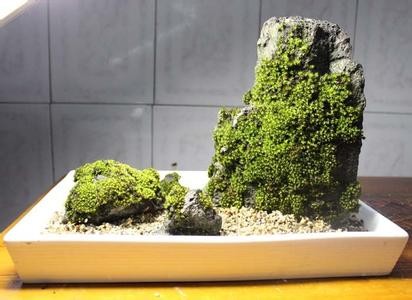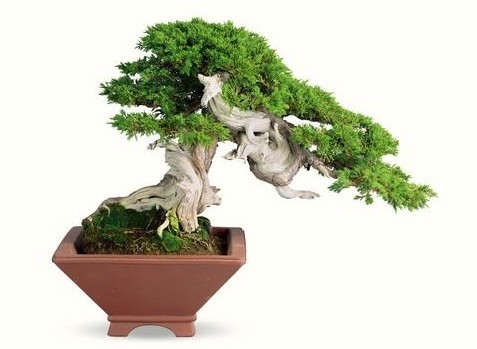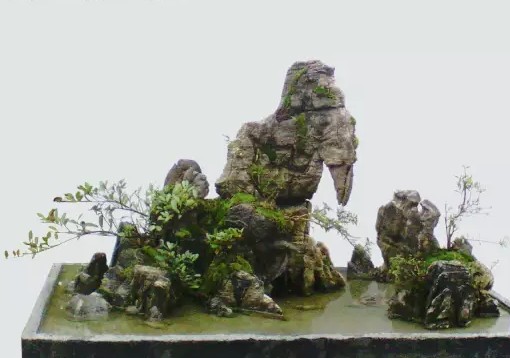The skill of landscape bonsai auxiliary moss and verdant
General root stone, strong water absorption, easy to grow moss; hard stone such as long-term placed in a damp cool place, the lower part can also grow thin moss. From the mossy part, there are more mosses at the lower part of the rock, less moss at the upper platform, less moss on the light surface and more moss on the backlight surface; There is less moss on the ridge and more moss in the mountain depression. This is the law of natural ecology. From front to back, all the mosses are spread, which lacks reality and damages the natural beauty of the rock.

Moss can be scraped off the mountain surface or corner of the damp place and spread directly on the pseudo-rock; Moss can also be crushed and mixed into thin mud or rice soup, and brushed on the rock with a brush; It can also be sprayed on the rock with thin fertilizer liquid, covered with plastic bag, and placed in a cool place with scattered light. Moss can soon grow on the bonsai of the rock.
Moss used for seed should be collected from poolside, wall foot, trunk, forest and other places with good environment. The planting position of moss should conform to the natural law. Pay attention to the change of primary and secondary, size, aggregation and dispersion, and follow the principle of "there is a deep valley in the shade, but there is no mountain in the sun". Moss should be pruned in time to properly set off the beauty of the stone.
Moss, like our fathers, humble and strong, simple and persistent. Moss grows well in acidic soils if it turns yellow. Ferrous sulfate solution may be used several times. This is how bonsai moss is made.
Moss is generally used in potted plants only as a pot soil to maintain moisture. However, the moss in the water stone basin spread culture, as moss bonsai independent viewing, in fact, do not have charm. Moss bonsai is more common in Japan. "Three parts to raise grass, seven parts to raise people", spring morning, lower body, with the recovery of moss together with the initial sense of life wild breath.
Time: 2019-06-04 Click:
- Prev

Bonsai with dried trees
The old trees in nature have been destroyed by lightning, wind, frost, snow and rain, falling stones and diseases, some of the trees have withered, the bark has peeled off, and the xylem is ossified. The natural formation and peeling off of the bark at the end of the trunk or branch in this mountain is called the natural god, while the white ossification of the xylem of the dry body is called Shelley.
- Next

How to plant plants for landscape bonsai
When configuring trees on landscape bonsai, we should choose tree species and ecological shape according to the needs of artistic conception. The tree species commonly used for planting are five-needle pine, small-leaf Luohan pine, June snow, melon seed yellow poplar, small-leaf elm, sparrow plum, lobular privet and so on, and herbaceous plants such as asparagus, Cuiyun grass, catgrass, iron fern and Phoenix tail fern, etc.
Related
- Fuxing push coffee new agricultural production and marketing class: lack of small-scale processing plants
- Jujube rice field leisure farm deep ploughing Yilan for five years to create a space for organic food and play
- Nongyu Farm-A trial of organic papaya for brave women with advanced technology
- Four points for attention in the prevention and control of diseases and insect pests of edible fungi
- How to add nutrient solution to Edible Fungi
- Is there any good way to control edible fungus mites?
- Open Inoculation Technology of Edible Fungi
- Is there any clever way to use fertilizer for edible fungus in winter?
- What agents are used to kill the pathogens of edible fungi in the mushroom shed?
- Rapid drying of Edible Fungi

